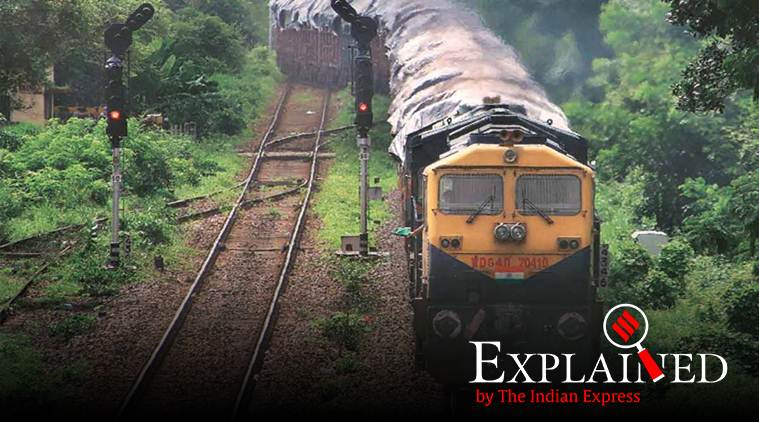- India
- International
Explained: 120-year-old rail track at heart of green alarm in Goa wildlife sanctuary
Diversion of 128.28 hectares in Western Ghats’ ecologically sensitive area, declared as a Unesco Heritage site; no mention of tiger corridor; local extinction of species endemic to Western Ghats.
 Doubling of rail track laid in 1900 between Hospet, now an industrial hub, and Vasco port, with 25 km cutting through forest land between Castle Rock and Kulem. (File Photo/Representational)
Doubling of rail track laid in 1900 between Hospet, now an industrial hub, and Vasco port, with 25 km cutting through forest land between Castle Rock and Kulem. (File Photo/Representational)
Environmentalists on the Goa State Wild Life Board (GSWLB) have raised concerns over clearances granted at the state and central level to three infrastructure projects, cutting the Western Ghats east of Goa into three large fragments, erasing 170.835 hectares of forest land within protected areas, and leading to the axing of at least 37,000 trees.
Consider the three projects, their benefits, and the concerns raised:
Double-tracking
PROJECT: Doubling of rail track laid in 1900 between Hospet, now an industrial hub, and Vasco port, with 25 km cutting through forest land between Castle Rock and Kulem.
BENEFITS: Temporary employment to 1,46,000; South Western Railway say double-tracking will help transport of ore and coal, and improve tourism potential for Hospet and Goa; connectivity to coastal region with interior regions of Karnataka; economic development and employment opportunities to Uttara Kannada, Belagavi, Bagalkote, Hubballi-Dharwad, Ballari and other northern districts of Goa; smooth movement of mining ore from Ballari to port.
MITIGATION MEASURES: 8 underpasses for animal passage; gate in tunnel that can be opened through mechanical or electronically controlled switches before train arrival so that wild animals are not trapped.

OBJECTIONS: Diversion of 128.28 hectares in Western Ghats’ ecologically sensitive area, declared as a Unesco Heritage site; no mention of tiger corridor; local extinction of species endemic to Western Ghats.
4-lane NH
PROJECT: Four-laning of existing 12-km stretch of NH4A between Anmod and Mollem, through Bhagwan Mahaveer Wildlife Sanctuary and its core notified area, Mollem National Park, connecting Goa and north Karnataka. Requires 32.085 hectares of forest land, with environmental loss estimated at Rs 3,659.807 lakh.
BENEFITS: Linkage between NH-4 and NH-17 connecting Panaji to Belagavi; fewer road accidents due to increased capacity; estimated saving of fuel worth Rs 272.9 crore per year. Goa Public Works Department (PWD) says the project will create 3,00,000 temporary jobs, and lead to establishment of small, medium and largescale industries due to better transport facilities, and regional economic development.
MITIGATION MEASURES: Construction of rubble wall across contour lines to avoid soil erosion; wildlife crossings (underpasses with dimensions as per size of animals); signage to allow wild animals on priority; boards at entry points to caution vehicles.
OBJECTIONS: Will fragment wildlife refuge; felling of over 12,000 species of trees will alter plant communities and erode plant diversity; will promote weeds and exotic species that outcompete native plants and alter animal use; will shift animal corridors due to noise pollution and traffic; change geography due to landslides and soil erosion.
Transmission line
PROJECT: 10-km power transmission line from Sangod in Goa to the Karnataka border across 11.54 hectares of forest land in protected area.
BENEFITS: Additional 400kV feed from Karnataka to meet Goa’s peak electricity demand of 1192 MW by 2022, according to Goa-Tamnar Transmission Project Ltd.
MITIGATION MEASURES: Install towers in a way that minimum trees are felled; construction and installation should not have adverse impact on wildlife habitat.
OBJECTIONS: High-tension wires over Tambdi-Surla stream where large birds like raptors, hornbills fly; felling of 4,139 endemic trees; Environment Impact Assessment (EIA) not scrutinised by state wildlife board; forest stretch is host to various endemic species that help reduce fragmentation and degradation; help in bio-diversity conservation; enhance carbon sequestration; strengthen resilience of ecosystems and landscapes to climate changes; minimise impact of natural disasters by absorbing excessive rainfall and control stream flows.
(Source: EIA reports, impact reports by Goa Forest Department, minutes of GSWLB meeting on December 2, 2019, minutes of Standing Committee of National Board for Wild Life meetings on December 17, 2019, and April 7, 2020, and project proponent reports)
EXPRESS OPINION
Apr 24: Latest News
- 01
- 02
- 03
- 04
- 05









































